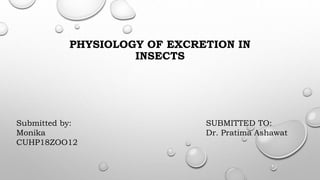
Physiology of excretion in insects
- 1. PHYSIOLOGY OF EXCRETION IN INSECTS Submitted by: Monika CUHP18ZOO12 SUBMITTED TO: Dr. Pratima Ashawat
- 2. EXCRETION The removal of the nitrogenous waste products of metabolism from the body is known as excretion. The organs of excretion in insects are: I. The Malpighian tubules II. The rectum The accessory organs of excretion are: I. Nephrocytes II. Oenocytes III. Labial glands IV. Urate cells V. Chloride cells
- 3. Generalized structure of insect gut showing excretory organs
- 4. Malpighian tubules These are the main excretory organs in insects. These are fine, unbranched and thread-like processes. These are the outgrowth of alimentary canal and present at the junction of midgut and hindgut. These are absent in spring tail and aphids, 2 in scale insects, 4 in bugs, 5 in mosquitoes, 6 in moths and butterflies, 60 in cockroach and more than 200 in locusts. The walls of Malpighian tubule consists of 4-6 large epithelial cells arranged in a circle which externally rests on the basement membrane. It is divided into two parts: 1. Distal secretary part having honey comb border. 2. Proximal absorptive part having brush border.
- 7. PHYSIOLOGY OF EXCRETION I. MECHANISM OF EXCRETION The terrestrial insects are uricotelic while the aquatic insects are often ammonotelic. In haemolymph, uric acid+ sodium= sodium urate uric acid+ potassium= potassium urate These sodium and potassium urate are highly soluble in water and easily absorbed by Malpighian tubules.
- 8. Physiology of excretion in insects in which Malpighian tubule is differentiated: In some insects, like Rhodnius, the tubules are differentiated into two parts: distal part and proximal part The distal part secrete ions, uric acid, amino acids and water from haemolymph, which is known as primary urine or simply urate. The urate then flows toward the proximal part during which the uric acid precipitates. In alkaline pH. Carbonic anhydrase splitting Bicarbonates + uric acidurate
- 9. The carbonic anhydrase is secreted by epithelial cells of Malpighian tubules, subsequently, water and bicarbonates are reabsorbed into blood. Uric acid is left into the lumen of tubules, from where it moves into lumen of hindgut. In hindgut more water is reabsorbed by rectal wall and return to haemolymph or blood. 𝐻2O 𝑁𝑎+ 𝐾+urate pH 6.6 Brush border pH 7.2 Honeycomb border Mechanism of excretion in Rhodnius
- 10. Physiology of excretion in insects in which Malpighian tubule is undifferentiated In insects like Carausius Malpighian tubule is not differentiated into distal and proximal parts. So the entire tubule functions as a distal part absorbing only salts while conversion into uric acid occurs in the rectum. There is continuous release of large quality of water from tubule into rectum drives uric acid along it and is eliminated through faeces through anus.
- 11. 𝐾+ Other ions c Urate SugarsAmino acids Urea 𝑁𝑎+ 𝐻2O pH 6.9- 7.5 Mechanism of excretion in Carausius 𝐾+ Other ions
- 13. Functions of excretory system: i. It involves filtration of the fluid of haemolymph excluding the proteins which cannot penetrate through the membrane. ii. It maintains the ionic and water balance of the haemolymph. So help in osmoregulation.
- 14. 2. URINE AND EXCRETORY END PRODUCTS The physical and chemical properties of urine vary among insects according to their food and environment. In fluid feeders, urine appears as a crystal-clear fluid. In aquatic insects, urine is copious and clear. The urine changes from alkaline to acid as it moves from Malpighian tubules to the gut, due to gradual fall from pH. 7.2-7.8 to 6.0- 6.6, respectively.
- 15. The chemical composition of urine varies in various insects. Urine contain water and salts. Salts include: 1. Bicarbonates and chlorides of sodium and potassium. 2. Phosphates of magnesium and calcium. 3. Sulphates derived from metabolism of cystine and methionine. 4. Nitrogen in form of uric acid, ammonia, urea and amino acids. 5. Pigments and other trace constituents.
- 16. a. Nitrogenous end products i. Uric acid It is nitrogenous end product of terrestrial insects. It require a little quantity of water for its discharge . The uric acid is derived from metabolism of purines and from the proteins by utilizing glycine, glutamine and aspartate: adenine hypoxanthine xanthine guanine Uric acid
- 17. ii. Ammonia It is mainly excreted by aquatic insects. It is excretory end product in larvae of Calliphora and Lucilia which are meat- feeders. It is very toxic substance and require large amount of water for elimination. It also occurs in terrestrial insects like Melanoplus. iii. Urea The insect urine also contain small amount of urea. Example-0.3- 0.4% in Melanoplus and 10% in mosquitoes.
- 18. iv. Amino acids Amino acids like leucine, histidine, histamine and arginine occur predominantly. Taurine, valine, phenylalanine, glycine and alanine are present in trace amount in insects like Rhodnius, melanoplus and Bombyx. Cystine is found in urine of carpet beetle, Attagenus and the wool moth, Tineola. Other nitrogenous compound include: 1. Xanthine and hypoxanthine – Galleria, Melophagus etc. 2. Allantoine – collembola, Bombyx, Carausius etc. 3. Allantoic acid – lepidoptera and larval Hymenoptera. Uric acid allantoine Allantoic acid Urea + glyoxalic acid Ammonia +CO2 uricase allantoinaseallantoicase urease
- 19. b. Pigments Pteridines are the common pigments present in insect urine. Other are leucopterine and isoxanthopterins found in some insects. c. Other trace constituents Calcium carbonate and calcium oxalate is found in urine of plant feeding and phasmids. Other pigments like ommochrome, biliverdin, salicylic acid, orthophosphates etc. are also found in many insects.